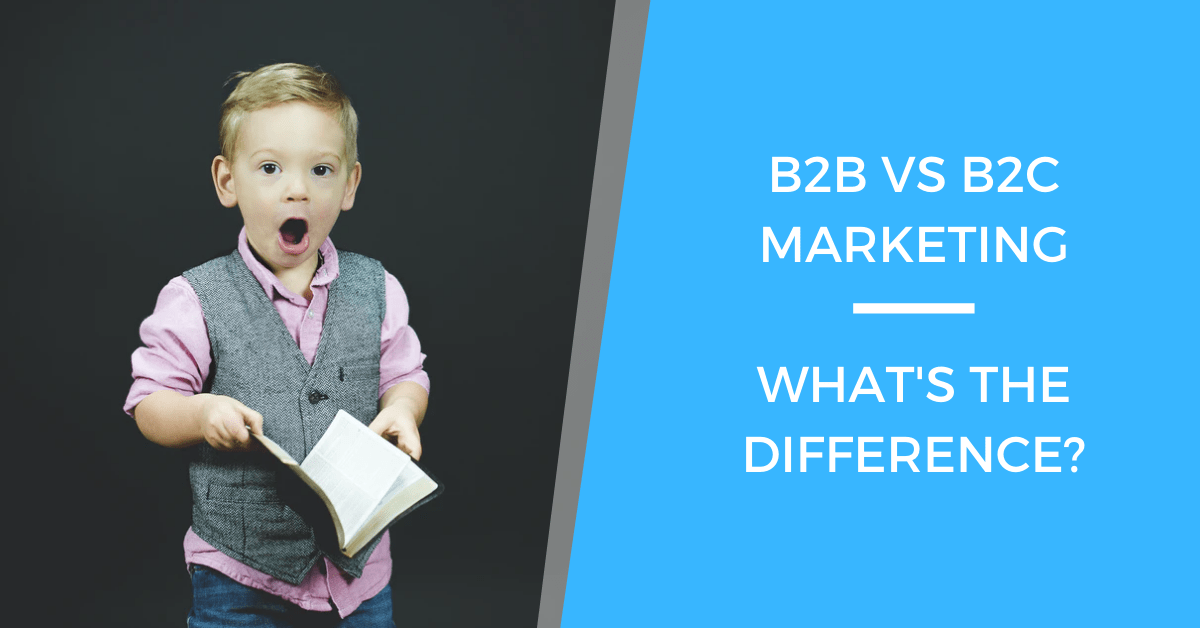What’s The Difference Between B2B vs B2C marketing?

The typical answer to this question is: “B2B is more logical, B2C is more emotional” — the problem with this answer is (1) it’s only accurate some of the time and (2) it’s not actionable advice.
Most marketers – and recruiters – think way too rigidly about B2B marketing vs B2C marketing, thinking that they’re completely different disciplines with no relevant overlap. This is wrong.
If you really want to understand the “difference” then we have to look at the question from another angle:
Is B2B Marketing Really More “Logical”?
The reason that B2B is often said to be “more logical” is because B2B is usually shorthand for “expensive enterprise purchase” which typically involves things like multiple decision makers, budget approval, security reviews, legal teams involvement and procurement departments.
In theory, what should happen is that slowing down the purchase process by involving multiple people forces everyone to activate their system 2 thinking – thereby making the purchase more logical and rational.
In reality, what’s happened is this: instead of just 1 person being involved, you now have 5-10 human beings involved, all with their own agendas and personal relationships, and now group psychology and social dynamics are now a factor in the decision. There is now plenty of room for irrationality and emotions (specifically, loss aversion) to enter the picture. Nobody ever got fired for buying IBM.

Okay. Let’s play along, and say that we’re pointing out an edge case; that as a whole, involving more people involved means a higher quality, more logical decision.
But do all B2B purchases play out like that?
Plenty of B2B purchases are made with your gut
Taking a step back, “B2B purchase” could also mean buying pens for the office. Hiring a freelance graphic designer. Buying SaaS software that you can expense with a credit card. Buying domain names for a microsite.
In these cases where the stakes are lower, there’s less pure “logic and reason” involved.
For B2B purchases like these, buyers are likely to engage in satisficing behavior – where you’re okay making a suboptimal, not totally logical decision – because you have bigger fish to fry.
For example, imagine being a marketer who has to create an ebook under time pressure:
I’m stressed out. I need to get this thing done. So I’m just going to hire the last freelancer I worked with, even though he was just okay … I could probably get better quality elsewhere, but this guy is good enough and I don’t want to look like an idiot delaying this project and take a risk on someone new.
Does that sound like a totally logical, objective buying process to you?
Is B2C Marketing Really More “Emotional”?
When people say “B2C” – it’s usually shorthand for “things you can buy in a grocery store” – low number of decision makers, and lots of opportunity for repeat purchase.
But not all B2C buying decisions look like this.
We make many B2C purchases where we suppress our emotions
Signing up for a home mortgage, buying a podcast mic or booking an anniversary cruise for your parents are also B2C. The buyer journeys for these purchases are completely different from buying peanut butter. In fact, I’m betting they resemble more of what we’d traditionally think of as B2B purchase decision – lots of research, lots of feature comparison, lots of asking around.
In these B2C purchases, the cost of being wrong is really high (do you really want to book a bad cruise for your parents?) and so while emotions play a part, you are actively trying to make an objectively good decision.

And it’s not just for high ticket items. Deep research and “logical” purchases in B2C happen all the time. It’s the reason why influencers make so much money on affiliate programs. It’s why The New York Times acquired Wirecutter.
Because B2C marketing, contrary to the trope of being “just about emotions”, often involves people who are trying to make the best possible decision while actively reducing their emotional engagement.
Instead of Thinking about B2B vs B2C, Think In Terms of High Involvement vs Low Involvement
It’s more useful to group things in terms of purchases along these dimensions:
High involvement purchases
The risk of making a poor decision is high. There are social risks (I’ll look like an idiot), financial risks (this purchase presents a significant opportunity cost) and outcome risks (I dont make this decision often; or this decision is effectively not reversible).
Examples: switching CRM vendors, buying a mattress. On the surface, these look like their buyers journeys are from completely different universes, but looking deeper you’ll see they’re quite similar. The mental model of thinking about these as B2B and B2C is not that relevant.
Consider the buyer’s journey: You’ll ask for referrals. You’ll scour reviews online. You might ask for a demo. There’s a significant purchase involved. Making a poor decision is really going to bite you in the ass, so while emotions are involved, you actively try to keep them in check.
Therefore, the marketing is also quite similar: it’s a game of trust and risk reduction. You need to make sure you’re collecting reviews online; you need to run campaigns and create content that increases the know-like-and-trust factor to give your brand an advantage in the sales process.
Low involvement purchases
There are still risks in making a poor decision, but they’re easily reversible decisions, or they’re for perishable items so your barrier to trying is low.
Examples: buying sportswear, choosing where to register a domain name. Again, on the surface these look like they’re from completely different universes. But not really. Both of these are industries where there are a zillion functional substitutes, and so companies have to stand out with branding and distinctiveness.
Low involvement is a game of mental availability. That’s why the marketing is so similar. It’s why GoDaddy ran outrageous Superbowl ads. It’s why Nike keeps coming up with ad campaigns, despite the fact that they probably have 100% brand awareness at this point.
What This Means For Marketers (and Recruiters)
Thinking in this way can change how you approach:
Recruiting & hiring:
If you’re a B2B SaaS startup who sells to SMBs, don’t just look for marketers who have B2B experience. Your first instinct will be to hire someone from Salesforce, but you might actually be better off hiring someone who used to do ecommerce marketing, where their experience with a lower-touch buyer’s journey is more relevant.
So many hiring managers & recruiters only think in terms of “we are a B2B company, therefore we only look for B2B marketers” – and not considering the relevance of that B2B marketing experience.
By thinking instead in terms of high/low involvement, you’ll increase the quality and quantity of your candidate pool.
Learning & getting better at marketing
B2B people tend to follow B2B people. B2C people tend to follow B2C people. And by doing so, you’re depriving yourself of a whole universe of learning.
Eye-opening example: if you think of yourself as a “B2B marketer”, can you name 3 B2C thought leaders, and vice versa?
Viewing things from a “low involvement” vs “high involvement” breaks down this false B2B/B2C barrier and opens you up to a much wider – and more relevant – range of people to learn from, books to read, blogs to follow, podcasts to listen to.
For example: if you’re doing marketing at a coding bootcamp, what are B2B analogues for a similar buyers journey, where there are similar financial and social risks involved? You might study how the best Sales training companies do their marketing, for example, allowing you to get new ideas where marketers aren’t normally looking.
What matters is the similarity of the buyers journey, and not whether something is B2B or B2C.